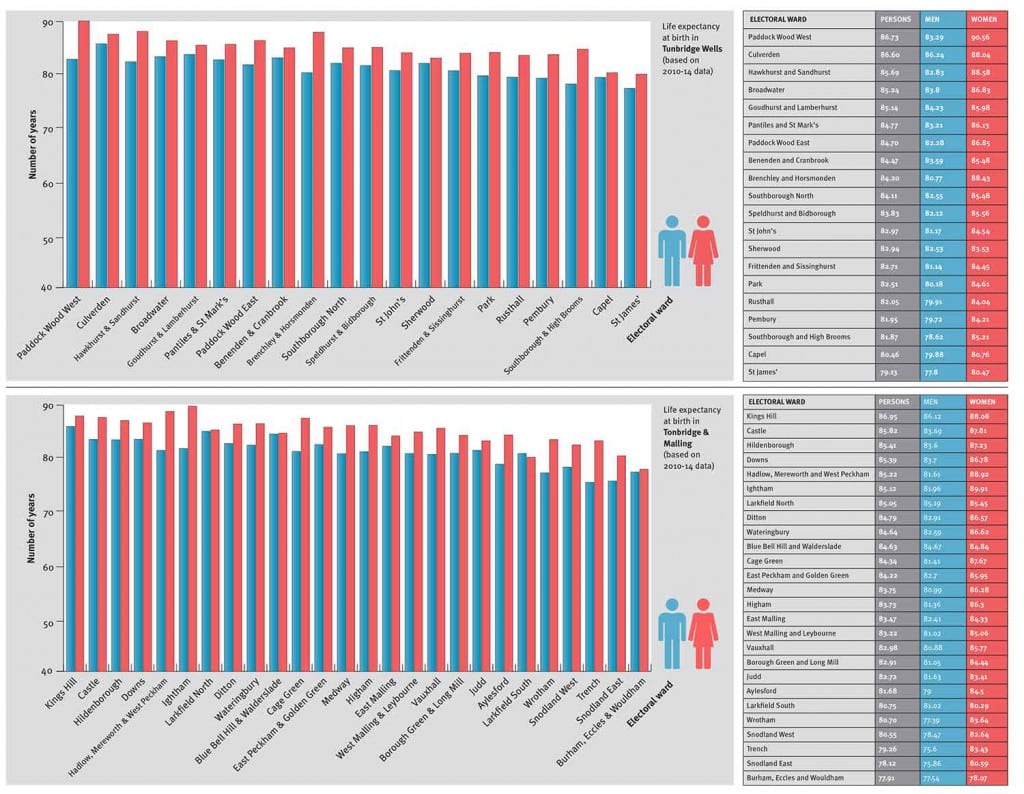Where you live in the borough can signpost how long you live, according to figures from Kent Public Health Observatory.
In Tunbridge Wells, for example, a woman at an address in Paddock Wood West is likely to live ten years longer than her counterpart in the St James’ Ward.
In Tonbridge & Malling the difference between people, (the average of both men and women), living in Kings Hill and those in the Ward of Burham, Eccles and Wouldham is just over nine years.
One expert told the Times that the figures reflect ‘people’s lifestyle, income and housing quality’. She also talked of ‘pockets of deprivation’.
The figures have been published by Kent Public Health Observatory, which provides intelligence through data collection, analysis and interpretation. Its work underpins health improvement across the county.
They give a detailed breakdown of each ward in the boroughs and highlight the stark differences in life expectancy for people residing just a few miles apart.
Those living in Paddock Wood West have an average life expectancy of 86.73, while residents of St James’ can only expect to reach 79.13.
The difference is even more pronounced when the figures only include women, with a gap of just over a decade between the two wards. In Paddock Wood West it’s 90.56 years while in St James’ Ward it’s 80.44.
At the moment, the women of Paddock Wood West are the only people in Tunbridge Wells borough who can expect to become nonagenarians.
The ward with the highest longevity for men is Culverden at 86.60 years.
However, the borough as a whole has the highest life expectancy in Kent, where the average life expectancy is 81.73 years.
People in Tunbridge Wells can expect to live up to 83.31 years.
The difference in life expectancy is even greater in the borough of Tonbridge & Malling, with a gap of just over nine years between Kings Hill (86.95) and the ward of Burham, Eccles and Wouldham (77.91).
Those living in the comparatively new town of Kings Hill can expect to live for an average of 86.95 years, while their counterparts in Burham, Eccles and Wouldham have an average life expectancy of 77.91 years.
However, unlike Tunbridge Wells, the ward with the highest average does not also have the highest female life expectancy.
This is held by the ward of Hadlow, Mereworth and West Peckham, where women can on average expect to live up to 88.92 years.
This is almost 12 years longer than females in Burham, Eccles and Wouldham, which is the only ward to have an average life expectancy for women under 80 years, at 78.07.
But the men of this ward fare better than those in Trench, which has the lowest life expectancy for men at 75.60 years, compared to the highest male average of 86.12 years at Kings Hill.
Adele Phillips, senior lecturer in public health at Canterbury Christ Church University, said there were several factors which can explain the differences between areas on such a micro-scale. She said: “This is quite typical throughout the UK and is also reflected in broader patterns such as the north-south divide.
“The important thing for people to understand is not just the general area you live in, but also people’s lifestyle, income and housing quality.
“What you see in different areas are pockets of deprivation which can often be associated with poorer educational standards.
“Health is embedded in our neighbourhoods and it is more than just genetics which determine life expectancy.”
She added that in order to tackle the divide, society needs a ‘joined up’ approach to health provision which includes ensuring each child is given a decent education during their early years.
KCC Public Health Consultant Faiza Khan said: “Life expectancy from birth is calculated as a prediction based on current mortality rates within geographical wards.
“There is a well-established association between socioeconomic deprivation and health outcomes. The reasons behind this are numerous and our health can be affected by many factors.
“For example, the environments in which we live, learn, work and play, alongside cultural norms, behaviours and lifestyles.”









